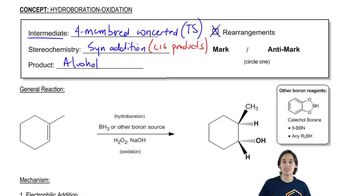Predict the major products of the following reactions.
d. trans-cyclodecene + peroxyacetic acid in acidic water
e. cis-cyclodecene + mCPBA in CH2Cl2, then dilute aqueous acid
 Verified step by step guidance
Verified step by step guidance Verified video answer for a similar problem:
Verified video answer for a similar problem:



 2:43m
2:43mMaster Anti-Markovnikov addition of alcohols to terminal alkynes yields aldehydes with a bite sized video explanation from Johnny
Start learning